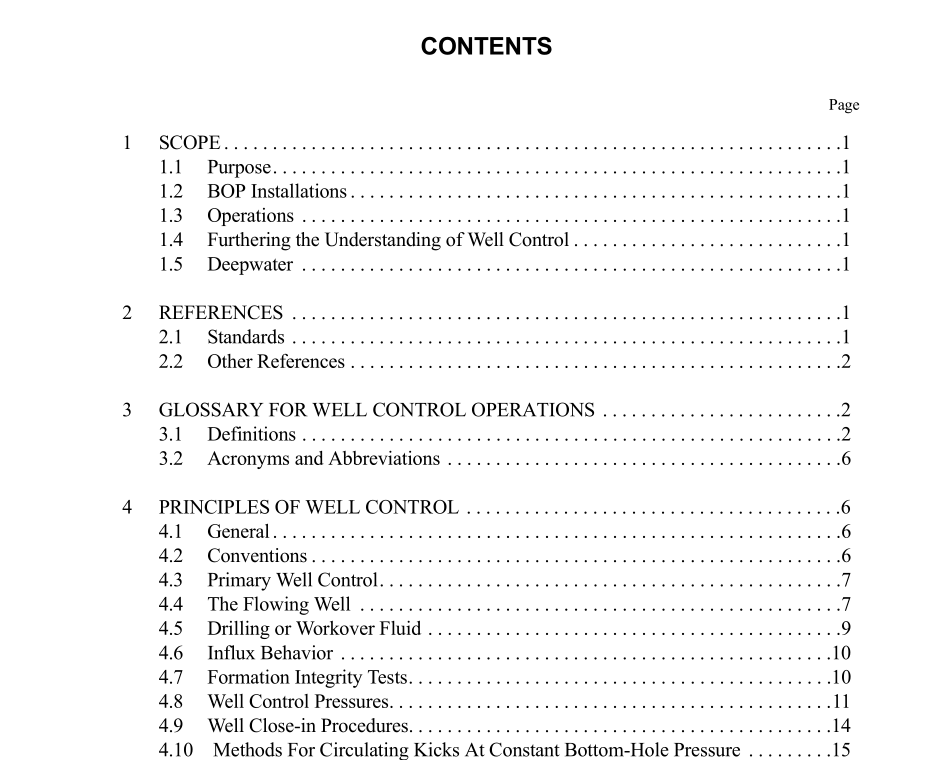API RP 59 pdf download

API RP 59 pdf download.Recommended Practice for Well Control Operations
1 Scope
1.1 PURPOSE
The purpose of these recommended practices is to provide information that can serve as a voluntary industry guide for safe well control operations. This publication is designed to serve as a direct field aid in well control and as a technical source for teaching well control principles. This publication establishes recommended operations to retain pressure con- trol of the well under pre-kick conditions and recommended practices to be utilized during a kick. It serves as a companion to API RP 53, Recommended Practice for Blowout Preven- tion Equipment Systems for Drilling Wells and API RP 64 Recommended Practice for Diverter Systems Equipment and Operations (reader should check for the latest edition). RP 53 establishes recommended practices for the installation and testing of equipment for the anticipated well conditions and service and RP 64 establishes recommended practices for installation, testing, and operation of diverters systems and discusses the special circumstances of uncontrolled flow from shallow gas formations.
3 Glossary for Well Control Operations
3.1 DEFINITIONS 3.1.1 abnormal pressure: Pore pressure in excess of that pressure resulting from the hydrostatic pressure exerted by a vertical column of water with salinity normal for the geographic area. 3.1.2 accumulator: A pressure vessel charged with nitro- gen or other inert gas and used to store hydraulic fluid under pressure for operation of BOPs. 3.1.3 annular preventer: A device, which can seal around any object in the well bore or upon itself. Compres- sion of a reinforced elastomer packing element by hydraulic pressure effects the seal. 3.1.4 annulus: The space between the drill string and the inside diameter of the hole being drilled, the last string of cas- ing set in the well, or the marine riser.3.1.5 annulus friction pressure: Circulating pressure loss inherent in the annulus between the drill string and cas- ing or open hole. 3.1.6 backpressure (casing pressure, choke pres- sure): The pressure existing at the surface on the casing side of the drill string/annulus flow system. 3.1.7 barite plug: A settled volume of barite particles from a barite slurry placed in the well bore to seal off a pres- sured zone. 3.1.8 barite slurry: A mixture of barium sulfate, chemi- cals, and water of a unit density between 18 and 22 pounds per gallon (lb/gal). 3.1.9 belching: A slang term to denote flowing by heads. 3.1.10 bell nipple: A piece of pipe, with inside diameter equal to or greater than the BOP bore, connected to the top of the BOP or marine riser with a side outlet to direct the drilling fluid returns to the shale shaker or pit. Usually has a second side outlet for the fill-up line connection. 3.1.11 bleeding: Controlled release of fluids from a closed and pressured system in order to reduce the pressure. 3.1.12 blind rams (blank, master): Rams whose ends are not intended to seal against any drill pipe or casing. They seal against each other to effectively close the hole. 3.1.13 blind/shear rams: Blind rams with a built-in cut- ting edge that will shear tubulars that may be in the hole, thus allowing the blind rams to seal the hole. Used primarily in subsea systems.3.1.14 blowout: An uncontrolled flow of well fluids and/ or formation fluids from the well bore. 3.1.15 blowout preventer (BOP): A device attached to the casinghead that allows the well to be sealed to confine the well fluids to the well bore. 3.1.16 blowout preventer drill: A training procedure to determine that rig crews are completely familiar with correct operating practices to be followed in the use of blowout pre- vention equipment. A “dry run” of blowout preventive action. 3.1.17 blowout preventer operating and control system (closing unit): The assembly of pumps, valves, lines, accumulators, and other items necessary to open and close the blowout preventer equipment. 3.1.18 blowout preventer stack: The assembly of well control equipment including preventers, spools, valves and nipples connected to the top of the wellhead. 3.1.19 BOPE: An abbreviation for blowout preventer equipment.









